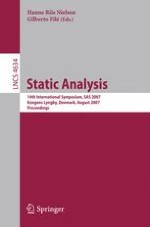The aim of static analysis is to develop principles, techniques and tools for validatingpropertiesofprograms,fordesigningsemantics-basedtransformations of programs and for obtaining high-performance implementations of high-level programming languages. Over the years the series of static analysis symposia has served as the primary venue for presentation and discussion of theoretical, practical and innovative advances in the area. This volume contains the papers accepted for presentation at the 14th Int- national Static Analysis Symposium (SAS 2007). The meeting was held August, 22–24, 2007, at the Technical University of Denmark (DTU) in Kongens L- gby, Denmark. In response to the call for papers, 85 submissions were received. Each submission was reviewed by at least 3 experts and, based on these reports, 26 papers were selected after a week of intense electronic discussion using the EasyChair conference system. In addition to these 26 papers, this volume also containscontributionsbythetwoinvitedspeakers:FrankTip(IBMT.J.Watson Research Center, USA) and Alan Mycroft (Cambridge University, UK). On the behalf of the Program Committee, the Program Chairs would like to thank all the authors who submitted their work to the conference and also all the external referees who have been indispensable for the selection process. Special thanks go to TerkelTolstrup and J¨ org Bauer,who helped in handing the submitted papers and in organizing the structure of this volume. We would also like to thank the members of the Organizing Committee at DTU for their great work. Finally we want to thank the PhD school ITMAN at DTU for ?nancial support.
